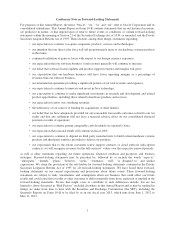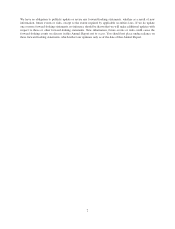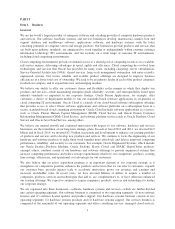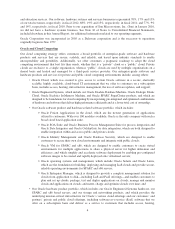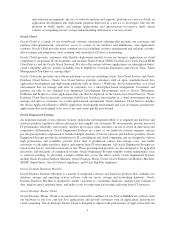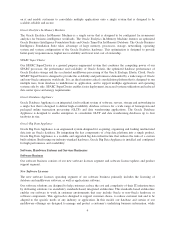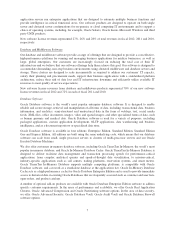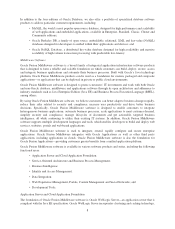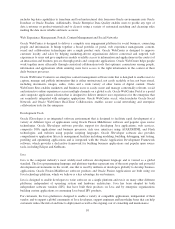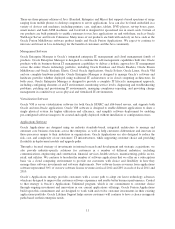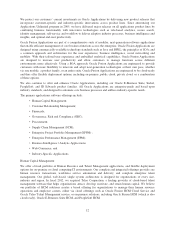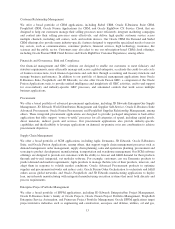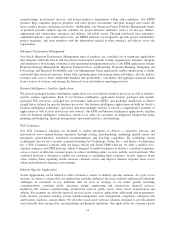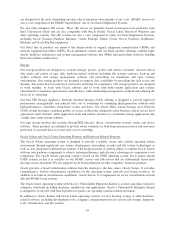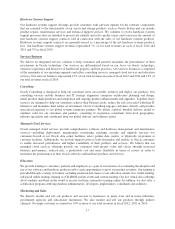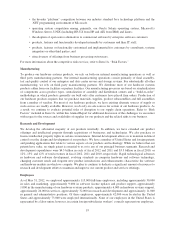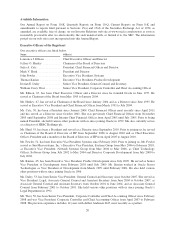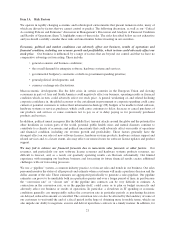Oracle 2012 Annual Report Download - page 15
Download and view the complete annual report
Please find page 15 of the 2012 Oracle annual report below. You can navigate through the pages in the report by either clicking on the pages listed below, or by using the keyword search tool below to find specific information within the annual report.
There are three primary editions of Java (Standard, Enterprise and Micro) that support a broad spectrum of usage
ranging from mobile phones to desktop computers to server applications. Java can also be found embedded in a
variety of devices and machines, including printers, cars, airplanes, tablets, DVD players, set-top boxes, pens,
smart meters and bank ATM machines; and JavaCard is designed for specialized use in smart cards. Certain of
our products are built primarily to enable customers to run Java applications on and with them, such as Oracle
WebLogic Server and Oracle Coherence. Many more of our products are built with and rely on Java, such as the
Oracle Fusion Middleware software product family and Oracle Fusion Applications. We expect to continue to
innovate and invest in Java technology for the benefit of customers and the Java community.
Management Software
Oracle Enterprise Manager is Oracle’s integrated enterprise IT management and cloud management family of
products. Oracle Enterprise Manager is designed to combine the self-management capabilities built into Oracle
products with its business-driven IT management capabilities to deliver a holistic approach to IT management
across the entire Oracle technology portfolio, including Oracle Database and Oracle Exadata, Oracle Fusion
Middleware and Oracle Exalogic Elastic Cloud, Oracle Applications, Oracle Solaris, Oracle Linux, Oracle VM
and our complete hardware portfolio. Oracle Enterprise Manager is designed to manage Oracle’s software and
hardware portfolio whether deployed using traditional IT architectures or in cloud computing architectures. In
both cases, Oracle Enterprise Manager is designed to provide a complete IT lifecycle management approach,
including configuring elements of an IT environment, monitoring service levels; diagnosing and troubleshooting
problems, patching and provisioning IT environments, managing compliance reporting, and providing change
management in a unified way across physical and virtualized IT environments.
Virtualization Software
Oracle VM is server virtualization software for both Oracle SPARC and x86-based servers, and supports both
Oracle and non-Oracle applications. Oracle VM software is designed to enable different applications to share a
single physical system for higher utilization and efficiency, and simplify software deployment by enabling
pre-configured software images to be created and rapidly deployed without installation or configuration errors.
Applications Software
Oracle Applications are designed using an industry standards-based, integrated architecture to manage and
automate core business functions across the enterprise, as well as help customers differentiate and innovate in
those processes unique to their industries or organizations. Oracle Applications are also designed to reduce the
risk, cost, and complexity of our customers’ IT infrastructures, while supporting customer choice and providing
flexibility in deployment models and upgrade paths.
Through a focused strategy of investments in internal research and development and strategic acquisitions, we
also provide industry-specific solutions for customers in a number of different industries, including
communications, engineering and construction, financial services, health services, manufacturing, public sector,
retail, and utilities. We continue to broaden the number of software applications that we offer on a subscription
basis via a cloud computing environment to provide our customers with choice and flexibility in how they
manage their software investments and software deployments. New software license revenues from applications
software represented 30% of our new software license revenues in fiscal 2012 and 28% in each of fiscal 2011 and
2010.
Oracle’s Applications strategy provides customers with a secure path to adopt our latest technology advances
which are designed to improve the customer software experience and enable better business performance. Central
to that strategy is Oracle’s Applications Unlimited program, which is our commitment to customer choice
through ongoing investment and innovation in our current applications offerings. Oracle Fusion Applications
build upon this commitment and are designed to work with and evolve customer investments in their existing
applications portfolio. Oracle Lifetime Support helps ensure customers will continue to have a choice in upgrade
paths based on their enterprise needs.
11


